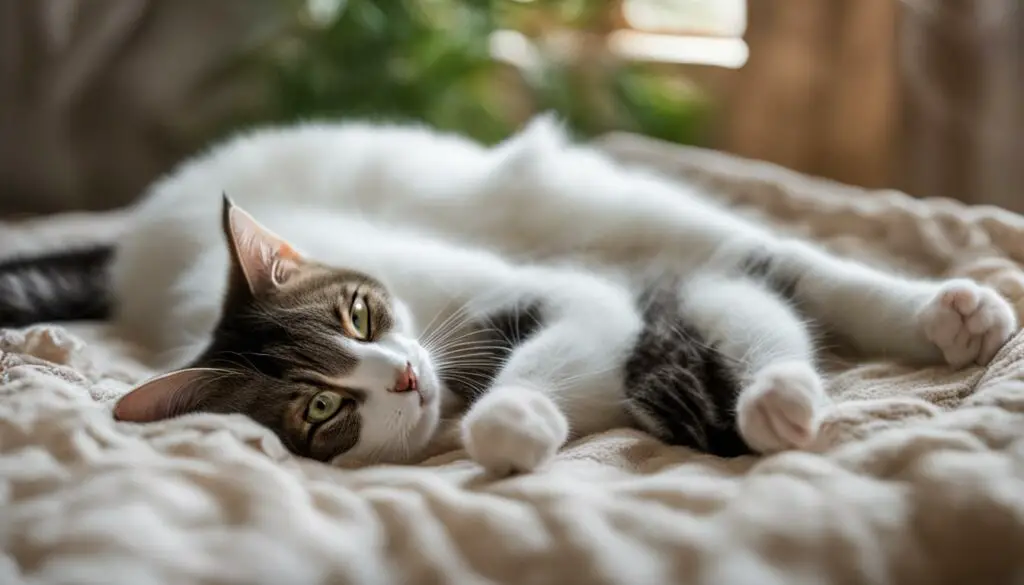As a cat owner, it’s essential to understand the importance of changing the bedding after your cat gives birth. The well-being and safety of both the mother and her kittens depend on it. But when exactly should you change the bedding? How often? And why is it so crucial? In this article, I will address these questions and provide you with valuable tips for proper bedding care after your cat gives birth.
Key Takeaways:
- Changing the bedding after a cat gives birth is vital for maintaining a clean and safe environment.
- The frequency of changing the bedding depends on factors such as the number of kittens and the mother cat’s ability to care for them.
- It is best to change the bedding at least once a day for the first week and then reduce the frequency as the kittens grow.
- The bedding should be clean, soft, and comfortable to provide a warm and cozy space for the mother and her kittens.
- Washing the bedding at least once a week is recommended, but it may need to be done more frequently if it becomes heavily soiled or smelly.
Why is it important to change the bedding after a cat gives birth?
Changing the bedding after a cat gives birth is crucial for the post-birth care of both the mother cat and her kittens. It helps maintain a clean and hygienic environment, which is essential for their health and well-being. Regularly changing the bedding prevents the buildup of bacteria and odors, reducing the risk of infections and ensuring the comfort of the mother and her kittens.
Keeping the bedding clean also provides a safe and supportive space for the kittens to grow. By removing any soiled or soiled bedding, you can minimize the chances of the kittens coming into contact with harmful substances or developing skin irritations. Additionally, it promotes better nesting conditions for the mother cat, aiding her recovery after the birth process.
Furthermore, changing the bedding regularly helps prevent the nesting area from becoming a breeding ground for parasites, such as fleas or mites. By maintaining a clean environment, you can safeguard the mother cat and her kittens from infestations and ensure their overall health and comfort.

Ensuring a Clean and Comfortable Environment
Regularly changing the bedding provides a clean and comfortable environment for the mother cat and her kittens. It helps create a nurturing space that supports their growth and development. By prioritizing their well-being and hygiene, you can contribute to their overall health and ensure a smooth transition into their new lives.
When should you change the bedding after a cat gives birth?
Knowing when to change the bedding after a cat gives birth is crucial for maintaining a clean and comfortable environment for the mother and her kittens. The timing of changing the bedding depends on various factors, including the mother cat’s ability to care for her kittens and any health concerns that may arise. In general, it is recommended to wait at least 24 hours after birth to allow the mother and kittens to bond before starting to change the bedding.
After the initial bonding period, the frequency of changing the bedding can be adjusted based on the specific needs of the mother and her kittens. During the first week, it is best to change the bedding at least once a day to ensure hygiene and cleanliness. This is a critical time when the kittens are vulnerable to infections and the mother may still be recovering from the birthing process.
As the kittens grow and the mother cat becomes more comfortable with caring for them, the frequency of changing the bedding can be gradually reduced to every other day or every few days. It is important to monitor the cleanliness of the bedding and change it as soon as it becomes soiled or smelly. By maintaining a consistent schedule of changing the bedding, you can provide a safe and comfortable environment for the mother and her kittens to thrive.
| Frequency of Changing Bedding | Recommended Timeframe |
|---|---|
| First week | At least once a day |
| Week 2 onwards | Every other day or every few days |
What is the best bedding to use after a cat gives birth?
Choosing the right bedding for a cat after giving birth is essential to ensure the comfort and well-being of the mother and her kittens. The best bedding options are those that are clean, soft, and provide a cozy environment. Towels, cloth diapers, or old t-shirts make excellent choices as they are absorbent and gentle on the mother’s skin. It is important to avoid rough or irritating bedding materials that may cause discomfort or skin irritations.
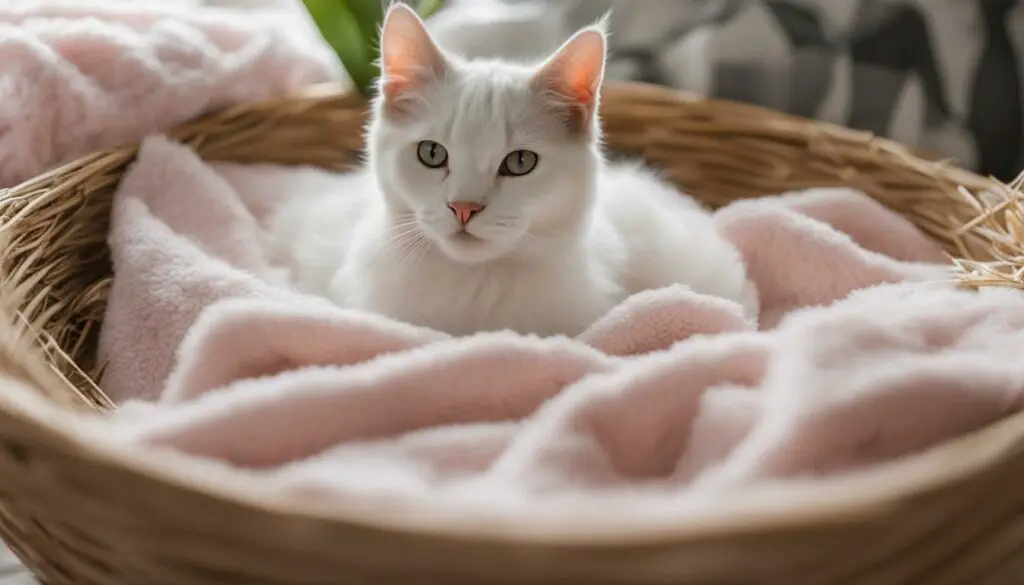
When selecting bedding, it is also vital to consider the nesting instinct of the mother cat. Providing materials that resemble natural nesting materials, such as towels or blankets, can help create a familiar and comfortable environment. It is important to remember that the bedding should be easily washable to maintain cleanliness and hygiene.
Table: Comparison of Cat Bedding Options
| Bedding Material | Advantages | Disadvantages |
|---|---|---|
| Towels | Absorbent, easy to clean | May become displaced easily |
| Cloth Diapers | Soft, absorbent, adjustable fit | Can be more expensive |
| Old T-shirts | Soft, easily available | May not be as absorbent |
Ultimately, the best bedding choice depends on the individual preferences of the mother cat and the specific needs of the kittens. Observing their behavior and comfort level can help determine the most suitable bedding material for their postpartum environment.
How often should you wash the bedding after a cat gives birth?
Keeping the bedding clean is crucial for the health and well-being of the mother cat and her kittens. But how often should you wash the bedding after a cat gives birth? It is recommended to wash the bedding at least once a week to ensure a clean and hygienic environment. However, if the bedding becomes heavily soiled or smelly, it may be necessary to wash it more frequently.
Having spare sets of bedding can be beneficial as it allows you to provide clean bedding while one set is being washed. This ensures that the mother and her kittens always have a clean and comfortable nesting area. It’s important to remember that the bedding should be washed using mild and cat-safe detergents to avoid any potential harmful effects.
To summarize, the frequency of washing the bedding after a cat gives birth depends on its condition. Washing it at least once a week and more frequently if needed helps maintain a clean and hygienic environment, promoting the health and well-being of both the mother and her kittens.
| How often to wash cat bedding after birth | Cat bedding wash frequency |
|---|---|
| At least once a week | Recommended frequency for washing the bedding after a cat gives birth |
| More frequently if heavily soiled or smelly | When the bedding becomes dirty or odorous, it may need to be washed more often |
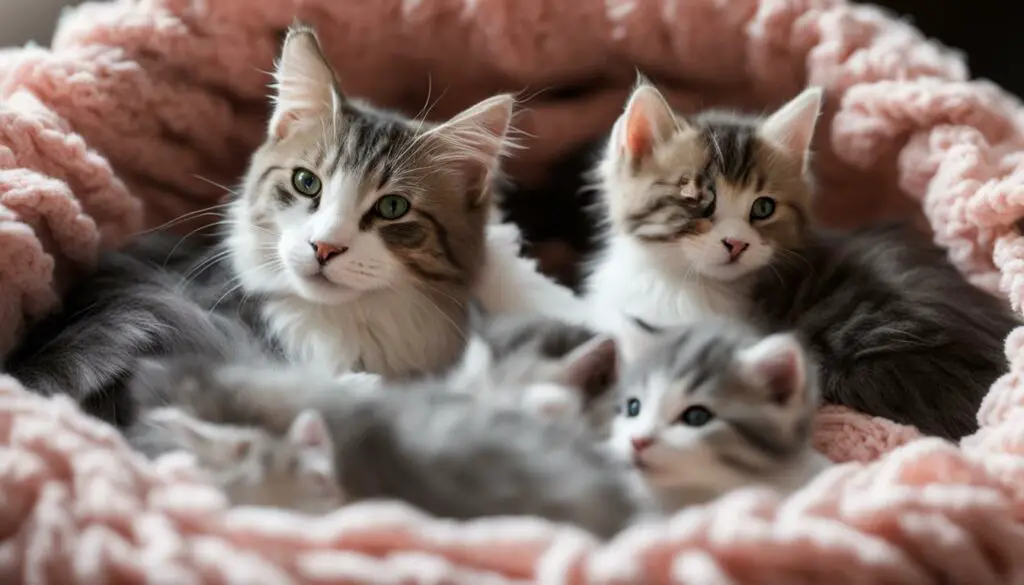
What should you do to care for the mother and kittens after birth?
After a cat gives birth, it is important to provide the mother with a clean and comfortable resting place. This could be a bed, box, or laundry basket lined with a towel. Food and water should be easily accessible for her, and regular monitoring of her health and the kittens’ wellbeing is necessary. Giving the mother cat privacy and minimizing disturbances while still conducting regular check-ups is key. Gradually increasing interaction with the kittens as they grow and ensuring they have a safe and warm environment are priority tasks for post-birth care.
To ensure the health and wellbeing of the mother and kittens, maintaining a clean environment is crucial. This includes regularly changing the bedding and keeping the nesting area tidy. Additionally, it is important to provide the mother cat with a nutritious diet to support her recovery and milk production. Consult with a veterinarian to ensure the mother cat is receiving adequate nutrition and to address any individual dietary needs or concerns.
Monitoring the mother cat and kittens
Observing the mother cat and her kittens closely is essential after birth. Keep an eye on the kittens‘ weight gain to ensure they are growing and thriving. If any kittens are not gaining weight or are showing signs of distress, consult a veterinarian for guidance. It is also important to monitor the mother cat’s behavior and health. Watch for any signs of illness or discomfort, such as decreased appetite, lethargy, or unusual discharge. Seeking prompt veterinary care if any concerns arise is crucial for the overall wellbeing of the mother cat and her kittens.
As the kittens grow, gradually introduce them to solid food alongside nursing. Consult with a veterinarian to determine the appropriate timing and type of food for the kittens. Providing a shallow dish with a high-quality kitten food and ensuring access to fresh water can help facilitate the weaning process. Additionally, continue to provide a clean and comfortable nesting area for the mother cat and her kittens, ensuring they have a safe and warm environment to grow and develop.
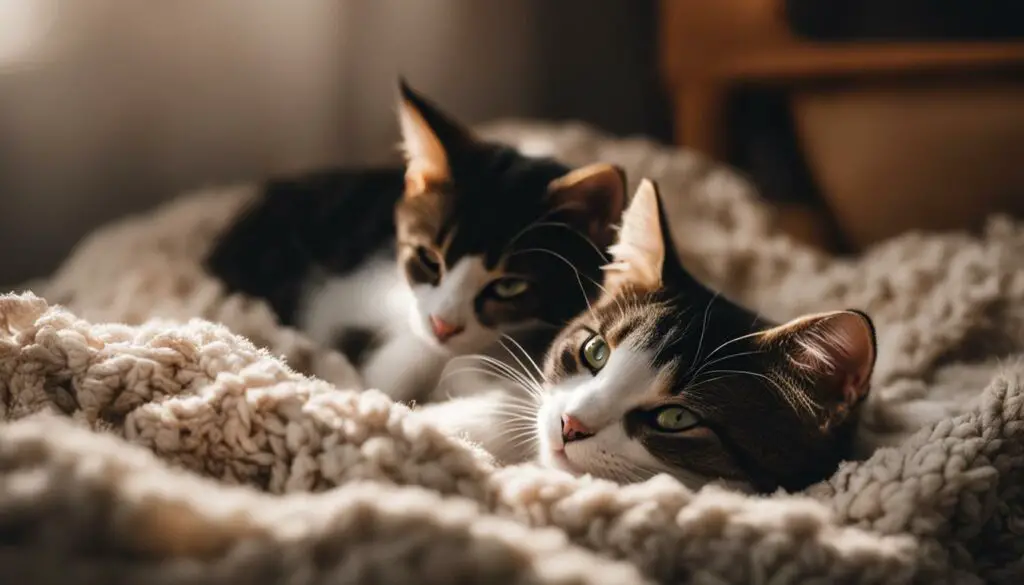
| Post-Birth Cat Care Checklist: |
|---|
| – Provide a clean and comfortable resting place for the mother cat |
| – Ensure easy access to food and water for the mother cat |
| – Minimize disturbances and maintain a quiet environment |
| – Change the bedding regularly to keep the nesting area clean |
| – Monitor the mother cat’s behavior and health |
| – Monitor the kittens’ weight gain and overall wellbeing |
| – Gradually introduce solid food to the kittens |
| – Consult with a veterinarian for guidance and support |
Precautions to Take When Changing the Bedding After Cat Gives Birth
When changing the bedding after a cat gives birth, it is important to take certain precautions to ensure the safety and well-being of the mother and her kittens. Here are some key precautions to keep in mind:
1. Be Gentle and Respectful
Handling the mother and her kittens with care is essential during the bedding change. Avoid any sudden movements or loud noises that may startle them. Approach them calmly and gently, allowing them to adjust to your presence. This will help reduce stress and keep the mother cat comfortable.
2. Create a Warm and Comfortable Environment
Before changing the bedding, ensure that the surrounding environment is warm and cozy. Kittens are more susceptible to temperature changes, so it’s important to maintain a stable and comfortable temperature. You can use a heating pad or a warm water bottle wrapped in a towel to provide additional warmth if needed.
3. Use Safe and Non-Toxic Cleaning Products
When cleaning the bedding, avoid using harsh chemicals or cleaning products that may be harmful to the cats. Opt for mild, non-toxic cleaners that are safe for animals. It’s best to choose products specifically made for cleaning pet bedding or consult with a veterinarian for recommendations.
4. Keep Other Animals Away
During the bedding change, it is important to keep other animals away from the nesting area. This helps prevent potential disease transmission and reduces stress for the mother and her kittens. Create a quiet and secure space where they can feel safe and undisturbed.
By following these precautions, you can ensure a smooth and safe bedding change for the mother cat and her kittens. Remember to always prioritize their well-being and consult a veterinarian if you have any specific concerns or questions regarding post-birth care.
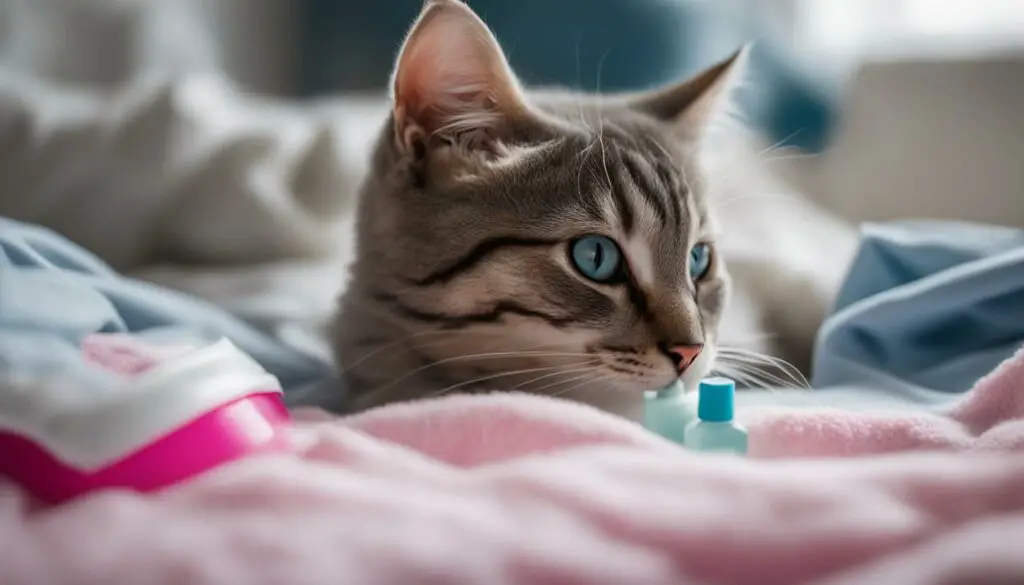
What to do if the mother cat does not accept the new bedding after birth?
After giving birth, some mother cats may exhibit resistance or discomfort when faced with changes in their bedding. It is important to remember that their natural instinct is to protect and familiarize themselves with their nesting area. If you encounter a situation where the mother cat rejects the new bedding, it is best to respect her preferences and allow her to adjust at her own pace.
One approach you can take is to provide alternative options for her to create a comfortable nesting space. This can include offering blankets or towels that have a similar scent or texture to her previous bedding. By doing so, you can help ease the transition and make the new bedding more familiar to her.
It is crucial to monitor her behavior and emotions during this adjustment period. If the mother cat continues to show signs of stress or aggression towards the new bedding, it may be necessary to consult with a veterinarian for further guidance and support.
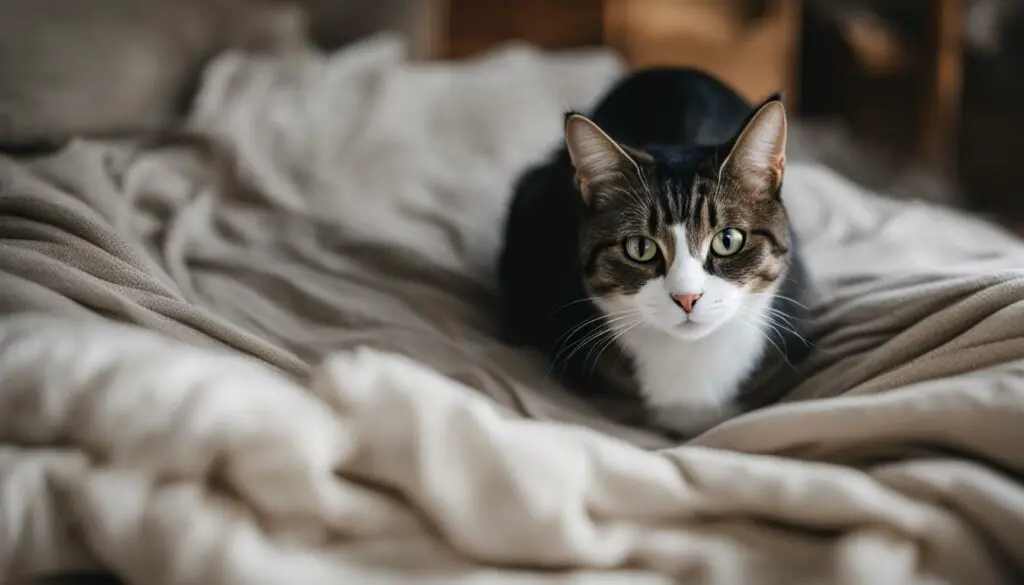
Tips for a smooth transition when changing the bedding after cat gives birth
- Be patient and allow the mother cat to adjust gradually
- Introduce small changes, such as adding a new blanket or towel while leaving some of the old bedding
- Provide plenty of positive reinforcement, such as treats and praise, to create a positive association with the new bedding
Remember, every cat is unique, and their reactions may vary. By understanding and respecting the mother cat’s preferences, you can help create a comfortable and nurturing environment for her and her kittens.
Tips for a Smooth Transition When Changing the Bedding After Cat Gives Birth
When changing the bedding after a cat gives birth, it’s important to ensure a smooth transition for both the mother cat and her kittens. Here are some tips to help make the process as stress-free as possible:
1. Gradual Introductions
Instead of immediately replacing all the bedding, consider introducing small changes gradually. Start by adding a new blanket or towel to the existing bedding, allowing the mother cat to become familiar with the new scent and texture. This gradual approach can help her adjust more easily to the new bedding.
2. Positive Reinforcement
Provide plenty of positive reinforcement during the bedding transition. Offer treats and praise to the mother cat when she accepts the new bedding or shows signs of relaxation in the updated environment. This positive association can help create a smooth and positive transition for both the mother and her kittens.
3. Patience and Observation
Be patient and observant during the bedding change process. Monitor the mother cat’s behavior and reactions closely. If she shows signs of stress or discomfort, take a step back and give her more time to adjust. Every cat is unique, and some may need more time to adapt to changes. By allowing her to acclimate at her own pace, you can help reduce anxiety and create a more comfortable transition.
Remember, each cat is different, so it’s essential to tailor your approach to their individual needs. By providing a gradual transition, positive reinforcement, and patience, you can help ensure a smooth bedding change and create a comfortable environment for the mother cat and her kittens.
| Tip | Benefits |
|---|---|
| Gradual Introductions | Reduces stress and helps the cat adjust to the new bedding |
| Positive Reinforcement | Creates a positive association with the new bedding |
| Patience and Observation | Allows the cat to acclimate at her own pace and reduces anxiety |
Following these tips can help make the transition when changing the bedding after a cat gives birth a smoother and more comfortable experience for both the mother cat and her kittens.
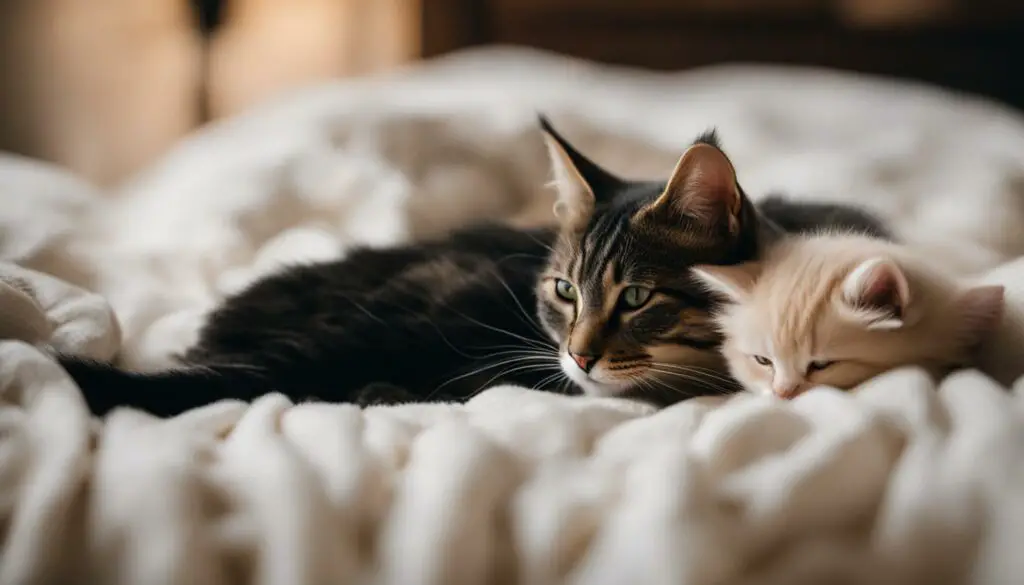
Aftercare for the Mother Cat and Kittens
After the bedding has been changed and the mother cat has given birth, it is crucial to provide appropriate aftercare for both the mother and the kittens. This includes ensuring a warm and safe environment, monitoring their health, and adjusting their diet to support their nutritional needs during lactation. Regular check-ups with a veterinarian are recommended to ensure the well-being of the mother cat and the healthy development of the kittens.
Creating a peaceful and stress-free environment for the mother cat and her kittens is vital for their well-being. Keep the area quiet and minimize disturbances, allowing the mother cat to care for her kittens without unnecessary interruptions. Monitor the mother cat’s health closely, looking out for signs of infection, mastitis, or any other medical issues. If you notice any concerning symptoms, consult a veterinarian for immediate assistance.
In terms of their diet, ensure that the mother cat is receiving a balanced and nutritious diet to support her milk production and overall health. High-quality commercial cat food formulated for lactating mothers is recommended. Additionally, provide fresh water at all times to keep the mother cat hydrated. As the kittens grow, you can gradually introduce them to solid food but continue to monitor their progress and consult a veterinarian for guidance.
During this post-birth period, it’s important to offer plenty of love and gentle interaction with the mother cat and kittens. Handle the kittens with care and avoid excessive handling in the first few days to allow the mother and kittens to bond. This will help promote a strong and nurturing relationship between them. Observe the kittens as they develop, ensuring they are feeding well, gaining weight, and displaying normal behaviors. If you have any concerns about their development, reach out to a veterinarian for advice.
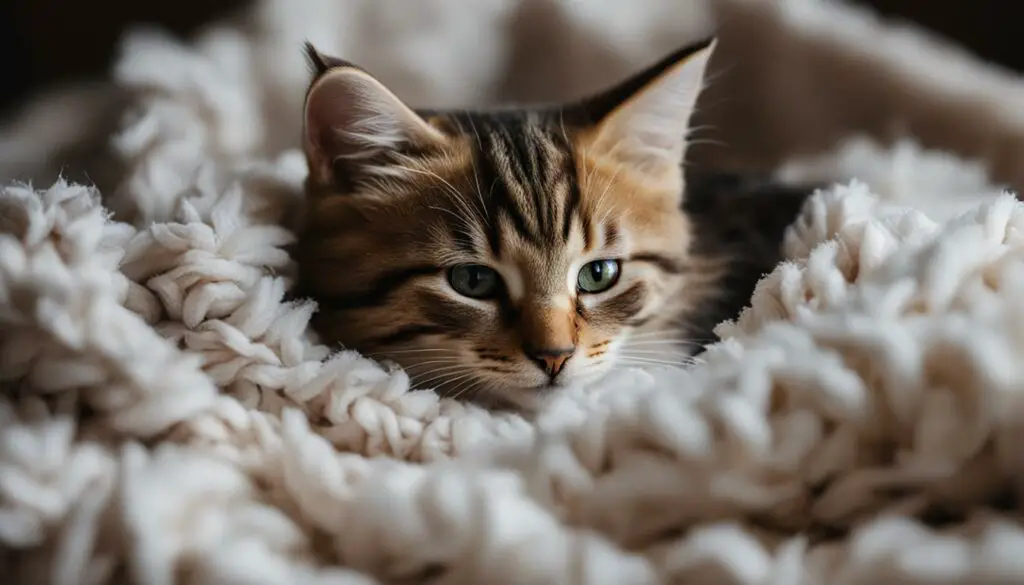
Common Mistakes to Avoid When Changing the Bedding After Cat Gives Birth
When changing the bedding after a cat gives birth, it is crucial to avoid common mistakes that can negatively impact the mother and her kittens. By being aware of these pitfalls and taking the necessary precautions, you can ensure a smooth transition and provide the best care for the new family.
“The biggest mistake to avoid is handling the kittens too much in the first few days. Although it is tempting to shower them with attention, excessive handling can cause stress to both the mother cat and the newborns. Remember, their immune systems are still developing, and they need time to bond and adjust to their new environment.”
Another common mistake is moving the kittens to a new location too soon. While you may want to clean the nesting area, it is essential to allow the mother cat to feel secure and comfortable. Abrupt changes can disrupt the bonding process and lead to anxiety or aggression.
Using harsh cleaning products near the mother and her kittens should also be avoided. Opt for gentle, pet-safe cleaners or simply use warm water to clean the bedding. Harsh chemicals can be toxic and harmful to the delicate immune systems of the kittens.
Lastly, never administer any medication or vaccinations to the mother cat without consulting a veterinarian. They will guide you on the appropriate timing and dosage to ensure the health and well-being of both the mother and her kittens.
Table: Common Mistakes to Avoid when Changing the Bedding After Cat Gives Birth
| Mistake | Impact |
|---|---|
| Handling the kittens too much | Can cause stress and hinder bonding |
| Moving the kittens to a new location too soon | Disrupts bonding process and leads to anxiety or aggression |
| Using harsh cleaning products | Chemicals can be toxic and harmful to the kittens |
| Administering medication or vaccinations without veterinary consultation | Potential health risks and improper dosage |

Essential Supplies for Caring for Mother Cat and Kittens After Birth
When it comes to caring for a mother cat and her kittens after birth, having the right supplies can make all the difference. Here are some essential items to have on hand:
- A quiet and safe space: Create a cozy area where the mother cat can nurse and bond with her kittens. This can be a bed, box, or laundry basket lined with a soft towel or blanket.
- Clean towels and blankets: Regularly change the bedding to maintain cleanliness and comfort for the mother and her kittens. Having spare sets of clean towels and blankets will ensure that you always have a fresh supply while one set is being washed.
- Kitten formula: In case the mother cat is unable to produce enough milk or if there are any concerns about the kittens’ health, it’s essential to have a good quality kitten formula on hand. Consult with a veterinarian to determine the appropriate brand and feeding schedule.
- Pet carrier: A sturdy and secure pet carrier is necessary for transporting the mother cat and her kittens to veterinary appointments or in case of any emergency situations. Choose a carrier that provides proper ventilation and enough space for the cats to move comfortably.
Additionally, it’s important to have patience, love, and understanding as you care for the mother cat and her kittens. The early weeks are critical for their growth and development, and creating a positive and nurturing environment will contribute to their well-being. Providing a warm and safe space, monitoring their health, and adjusting their diet to support their nutritional needs are all part of ensuring a healthy start for the new family.
“Having the right supplies can make all the difference in the care of a mother cat and her kittens after birth. From creating a cozy nesting area to ensuring proper nutrition, these essential items will help you provide the best care for the new family.”
To summarize, the essential supplies for post-birth cat care include a quiet and safe space, clean towels and blankets, kitten formula, and a pet carrier. These items will help you create a comfortable and nurturing environment for the mother cat and her kittens as they grow and thrive. Remember to consult with a veterinarian for specific guidance and to address any concerns you may have during this special time.
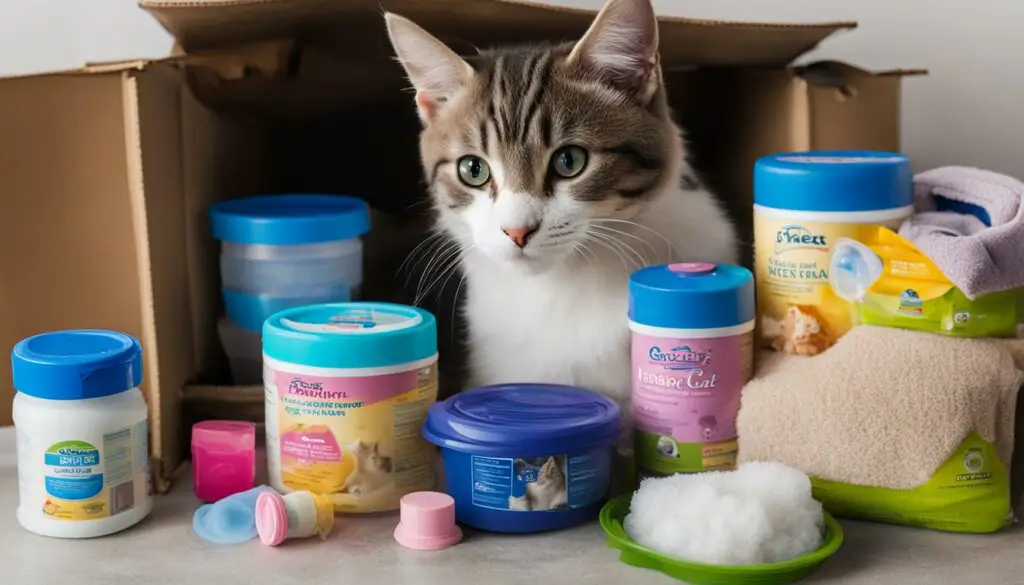
Conclusion
In conclusion, changing the bedding after a cat gives birth is crucial for the health and well-being of the mother and her kittens. By providing a clean and comfortable environment, we ensure their safety and create a nurturing space for them to grow and thrive.
Regularly changing the bedding helps prevent infections and provides a hygienic space for the kittens. It also supports the mother’s recovery after birth and prevents odor buildup in the nesting area.
Remember to be patient and gentle when handling the mother and her kittens during bedding changes. Taking the necessary precautions, such as avoiding cleaning products harmful to cats and keeping other animals away from the nesting area, will ensure a smooth and stress-free transition.
FAQ
When should you change the bedding after a cat gives birth?
The timing of changing the bedding after a cat gives birth depends on the individual situation. Generally, it is recommended to wait at least 24 hours after birth to allow the mother and kittens to bond. After this initial bonding period, it is safe to start changing the bedding as needed. However, if the mother cat is struggling to care for the kittens or if there are other health concerns, it may be necessary to change the bedding more frequently.
Why is it important to change the bedding after a cat gives birth?
Changing the bedding after a cat gives birth is important to keep the environment clean, comfortable, and safe for the mother and her kittens. It helps prevent infections, provides a hygienic space for the kittens to grow, and supports the mother’s recovery after birth. Regularly changing the bedding also helps to prevent odor buildup and keeps the nesting area conducive for the mother cat’s care.
What is the best bedding to use after a cat gives birth?
The best bedding to use after a cat gives birth is a clean, soft material that is absorbent and comfortable. Options include towels, cloth diapers, or old t-shirts. It is important to avoid bedding that is rough or irritating to the mother’s skin, as well as overly absorbent material that can become wet and uncomfortable. The goal is to provide a warm and cozy space for the mother and her kittens.
How often should you wash the bedding after a cat gives birth?
It is recommended to wash the bedding after a cat gives birth at least once a week. However, if the bedding becomes heavily soiled or smelly, it may be necessary to wash it more frequently. Having spare sets of bedding can be helpful to ensure that clean bedding is always available while one set is being washed. It is important to maintain a clean and hygienic environment for the mother and her kittens to thrive.
What should you do to care for the mother and kittens after birth?
After a cat gives birth, it is important to provide the mother with a clean and comfortable resting place. Food and water should be easily accessible for her, and regular monitoring of her health and the kittens’ wellbeing is necessary. Giving the mother cat privacy and minimizing disturbances while still conducting regular check-ups is key. Gradually increasing interaction with the kittens as they grow and ensuring they have a safe and warm environment are priority tasks for post-birth care.
Precautions to take when changing the bedding after cat gives birth
When changing the bedding after a cat gives birth, it is important to take precautions to avoid disturbing or stressing the mother and her kittens. This includes being gentle while handling them, ensuring the area is warm and comfortable, and providing a clean and safe environment. It is also essential to avoid using any cleaning products that may be harmful to the cats and to keep other animals away from the nesting area to prevent potential disease transmission.
What to do if the mother cat does not accept the new bedding after birth?
In some cases, a mother cat may be resistant to changes in bedding after giving birth. This can be due to her natural instinct to protect and familiarize herself with the nesting area. If the mother cat exhibits signs of stress or aggression towards the new bedding, it is best to respect her preferences and allow her to adjust at her own pace. Providing alternative options for her to create a comfortable nesting space, such as offering blankets or towels similar to her previous bedding, may help ease the transition.
Tips for a smooth transition when changing the bedding after cat gives birth
To ensure a smooth transition when changing the bedding after a cat gives birth, it is important to be patient and allow the mother cat to adjust gradually. Introducing small changes, such as adding a new blanket or towel while leaving some of the old bedding, can help her become familiar with the new scent and texture. Providing plenty of positive reinforcement, such as treats and praise, can also help create a positive association with the new bedding.
Aftercare for the mother cat and kittens
After the bedding has been changed and the mother cat has given birth, it is crucial to provide appropriate aftercare for both the mother and the kittens. This includes ensuring a warm and safe environment, monitoring their health, and adjusting their diet to support their nutritional needs during lactation. Regular check-ups with a veterinarian are recommended to ensure the well-being of the mother cat and the healthy development of the kittens.
Common mistakes to avoid when changing the bedding after cat gives birth
When changing the bedding after a cat gives birth, there are some common mistakes to avoid. These include attempting to handle the kittens too much in the first few days, moving the kittens to a new location too soon, using harsh cleaning products near the mother and kittens, and giving the mother cat any medication or vaccinations without consulting a veterinarian. It is important to prioritize the well-being and comfort of the mother and her kittens during this sensitive time.
Essential supplies for caring for mother cat and kittens after birth
To provide the best care for a mother cat and her kittens after birth, there are some essential supplies to have on hand. These include a quiet and safe space for them to spend the first few weeks, clean towels and blankets for bedding, a good quality kitten formula in case the mother is unable to produce enough milk, a pet carrier for vet visits if necessary, and patience, love, and understanding to create a positive and nurturing environment for the new family.

